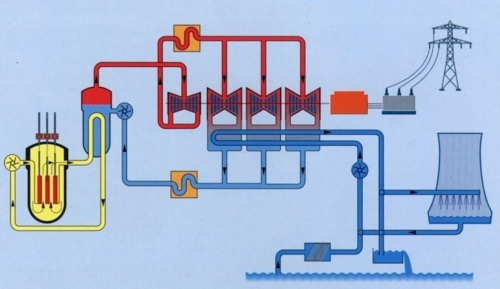 This schematic of a PWR shows the reactor in yellow with the steam generator next to it, feeding steam (shown in red) to the turbines.
This schematic of a PWR shows the reactor in yellow with the steam generator next to it, feeding steam (shown in red) to the turbines.
The Byron nuclear plant in Illinois has two pressurized water reactors (PWRs).
The Braidwood nuclear plant in Illinois also has two pressurized water reactors.
The four reactors are more like two sets of twins. Their designs are so close that Exelon, their owner, and the NRC often consider them collectively. For example, Exelon submitted one application on July 5, 2000, to the NRC for permission to increase the output from each of the four reactors by 170 thermal megawatts. And the NRC used a single report to approve the four power uprates.
Yet differences between Byron and Braidwood, exacerbated by differences between Byron Unit 1 and Byron Unit 2, transformed a recent startup into a rapid shut down.
On February 6, 2012, operators had the Byron Unit 2 reactor power level at 25% during startup. At that point, the startup procedures directed them to re-align the flow of feedwater to the steam generators. In PWRs like Byron and Braidwood, the water flowing through the reactor core is heated to over 550°F but is prevented from boiling due to pressure of more than 2,000 pounds per square inch. This hot and high pressure water flows through thousands of tubes inside the steam generators. Heat passes through the metal tube walls to boil water inside the steam generators (but outside the tubes). This steam spins the turbine connected to the generator to make the electricity. The feedwater system supplies water to the steam generators to replace the inventory lost as steam.
At Braidwood, the startup procedure has the feedwater control system in automatic mode for this process. This lessens the challenge faced by the operators during the system’s re-alignment – as they close valves, other valves automatically open the right amount at the right speed to maintain the proper balance between steam out and makeup water in. The water level inside the steam generators remains fairly constant throughout the re-alignment.
At Byron, the startup procedure has the feedwater control system in manual mode for this process. As operators closed valves, they had to open other valves to compensate. Because the valves had different sizes and characteristics, it was more than opening a valve halfway to offset closing one halfway.
Further complicating things, the control room simulator at Byron only modeled the feedwater control system for Unit 1. The feedwater control system for Unit 2 was different and behaved differently. But the operators never got to practice the steps necessary to manually re-align the feedwater control system on Unit 2.
On this day, winging it didn’t work so well. The operator closed valves and opened one too far to compensate. As a result, more feedwater flowed into the steam generator than left it as steam. The water level inside the steam generator increased due to the imbalance. Another operator noticed that water level was rising and alerted the operator at the controls. That operator closed the valve a little to reduce the feedwater flow rate, but the level continued rising. If the level rose to 80.8%, the reactor would automatically shut down. With the level above 70% and steadily rising towards the automatic trip setpoint, the senior operator ordered that the reactor be manually shut down.
That manual step was successfully undertaken. The Unit 2 startup turned into a Unit 2 shut down in seconds.
Our Takeaway
The operators at Byron Unit 2 were set up. Braidwood’s procedures placed the feedwater control system in automatic mode at this point in the startup when the system’s valves were re-aligned. But procedures at Byron had the operators perform the re-alignments with the control system in manual mode, significantly increasing the challenges they faced.
In addition to this unnecessary challenge, the operators were further hamstrung by never getting to practice these steps on the control room simulator. The Byron simulator only modeled the feedwater control system on Unit1; Unit 2 had a different feedwater control system and the operators had to figure out how it worked on the real reactor.
The public at Byron Unit 2 and every other reactor in the United States are also set up. In the case described here, operators receiving virtually no training on a system’s controls failed to properly control it, resulting in the reactor’s unplanned shut down. Operators nationwide receive virtually no training – or even less training than in this case – on the Severe Accident Management Guidelines designed to protect the public in event of an accident like that at Fukushima. The operators receive little training on these procedures and don’t practice them on control room simulators. Yet the public is assumed to be adequately protected by operators flawlessly using these procedures under the highly stressful conditions that just might be present in the control room during a major accident.
The NRC must give operators a realistic shot at protecting the public in event of an accident. Untrained and unpracticed is unfair.
“Fission Stories” is a weekly feature by Dave Lochbaum. For more information on nuclear power safety, see the nuclear safety section of UCS’s website and our interactive map, the Nuclear Power Information Tracker.
